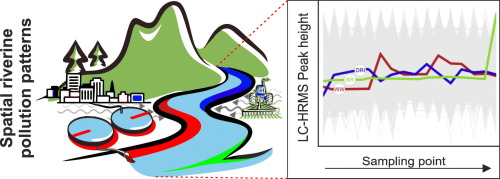当前位置:
X-MOL 学术
›
Sci. Total Environ.
›
论文详情
Our official English website, www.x-mol.net, welcomes your feedback! (Note: you will need to create a separate account there.)
Unraveling longitudinal pollution patterns of organic micropollutants in a river by non-target screening and cluster analysis.
Science of the Total Environment ( IF 9.8 ) Pub Date : 2020-04-06 , DOI: 10.1016/j.scitotenv.2020.138388 Liza-Marie Beckers 1 , Werner Brack 1 , Janek Paul Dann 1 , Martin Krauss 2 , Erik Müller 1 , Tobias Schulze 2
Science of the Total Environment ( IF 9.8 ) Pub Date : 2020-04-06 , DOI: 10.1016/j.scitotenv.2020.138388 Liza-Marie Beckers 1 , Werner Brack 1 , Janek Paul Dann 1 , Martin Krauss 2 , Erik Müller 1 , Tobias Schulze 2
Affiliation

|
The pollution of aquatic ecosystems with complex and largely unknown mixtures of organic micropollutants is not sufficiently addressed with current monitoring strategies based on target screening methods. In this study, we implemented an open-source workflow based on non-target screening to unravel longitudinal pollution patterns of organic micropollutants along a river course. The 47 km long Holtemme River, a tributary of the Bode River (both Saxony-Anhalt, Germany), was used as a case study. Sixteen grab samples were taken along the river and analyzed by liquid chromatography coupled to high-resolution mass spectrometry. We applied a cluster analysis specifically designed for longitudinal data sets to identify spatial pollutant patterns and prioritize peaks for compound identification. Three main pollution patterns were identified representing pollutants entering a) from wastewater treatment plants, b) at the confluence with the Bode River and c) from diffuse and random inputs via small point sources and groundwater input. By further sub-clustering of the main patterns, source-related fingerprints were revealed. The main patterns were characterized by specific isotopologue signatures and the abundance of peaks in homologue series representing the major (pollution) sources. Furthermore, we identified 25 out of 38 representative compounds for the patterns by structure elucidation. The workflow represents an important contribution to the ongoing attempts to understand, monitor, prioritize and manage complex environmental mixtures and may be applied to other settings.
中文翻译:

通过非目标筛选和聚类分析来揭示河流中有机微量污染物的纵向污染模式。
现有的基于目标筛选方法的监测策略无法充分解决有机微污染物复杂且很大程度上未知的混合物对水生生态系统的污染。在这项研究中,我们实施了一个基于非目标筛选的开源工作流程,以揭示沿河道的有机微量污染物的纵向污染模式。案例研究使用了47公里长的Holtemme河(博德河的支流)(都来自德国萨克森-安哈尔特)。沿河采集了16个抓取样品,并通过液相色谱和高分辨率质谱分析。我们应用了专为纵向数据集设计的聚类分析,以识别空间污染物模式并为化合物识别确定峰的优先级。确定了三种主要的污染模式,分别表示a)来自废水处理厂的污染物,b)与博德河汇合处的污染物,以及c)来自散布和随机输入(通过小点源)和地下水输入的污染物。通过进一步细分主要模式,揭示了与源相关的指纹。主要模式的特征是特定的同位素同位素特征和代表主要(污染)来源的同系物序列中的峰丰度。此外,我们通过结构解析确定了38种代表性化合物中的25种用于模式分析。该工作流程为正在进行的了解,监视,区分优先级和管理复杂环境混合物的尝试做出了重要贡献,并且可以应用于其他设置。b)与博德河汇合处,以及c)来自散布和随机输入的小点源和地下水输入。通过进一步细分主要模式,揭示了与源相关的指纹。主要模式的特征是特定的同位素同位素特征和代表主要(污染)来源的同系物序列中的峰丰度。此外,我们通过结构解析确定了38种代表性化合物中的25种用于模式分析。该工作流程为正在进行的了解,监视,区分优先级和管理复杂环境混合物的尝试做出了重要贡献,并且可以应用于其他设置。b)与博德河汇合处,以及c)来自散布和随机输入的小点源和地下水输入。通过进一步细分主要模式,揭示了与源相关的指纹。主要模式的特征是特定的同位素同位素特征和代表主要(污染)来源的同系物序列中的峰丰度。此外,我们通过结构解析确定了38种代表性化合物中的25种用于模式分析。该工作流程为正在进行的了解,监视,区分优先级和管理复杂环境混合物的尝试做出了重要贡献,并且可以应用于其他设置。揭示了与源有关的指纹。主要模式的特征是特定的同位素同位素特征和代表主要(污染)来源的同系物序列中的峰丰度。此外,我们通过结构解析确定了38种代表性化合物中的25种用于模式分析。该工作流程为正在进行的了解,监视,区分优先级和管理复杂环境混合物的尝试做出了重要贡献,并且可以应用于其他设置。揭示了与源有关的指纹。主要模式的特征是特定的同位素同位素特征和代表主要(污染)来源的同系物序列中的峰丰度。此外,我们通过结构解析确定了38种代表性化合物中的25种用于模式分析。该工作流程为正在进行的了解,监视,区分优先级和管理复杂环境混合物的尝试做出了重要贡献,并且可以应用于其他设置。
更新日期:2020-04-08
中文翻译:

通过非目标筛选和聚类分析来揭示河流中有机微量污染物的纵向污染模式。
现有的基于目标筛选方法的监测策略无法充分解决有机微污染物复杂且很大程度上未知的混合物对水生生态系统的污染。在这项研究中,我们实施了一个基于非目标筛选的开源工作流程,以揭示沿河道的有机微量污染物的纵向污染模式。案例研究使用了47公里长的Holtemme河(博德河的支流)(都来自德国萨克森-安哈尔特)。沿河采集了16个抓取样品,并通过液相色谱和高分辨率质谱分析。我们应用了专为纵向数据集设计的聚类分析,以识别空间污染物模式并为化合物识别确定峰的优先级。确定了三种主要的污染模式,分别表示a)来自废水处理厂的污染物,b)与博德河汇合处的污染物,以及c)来自散布和随机输入(通过小点源)和地下水输入的污染物。通过进一步细分主要模式,揭示了与源相关的指纹。主要模式的特征是特定的同位素同位素特征和代表主要(污染)来源的同系物序列中的峰丰度。此外,我们通过结构解析确定了38种代表性化合物中的25种用于模式分析。该工作流程为正在进行的了解,监视,区分优先级和管理复杂环境混合物的尝试做出了重要贡献,并且可以应用于其他设置。b)与博德河汇合处,以及c)来自散布和随机输入的小点源和地下水输入。通过进一步细分主要模式,揭示了与源相关的指纹。主要模式的特征是特定的同位素同位素特征和代表主要(污染)来源的同系物序列中的峰丰度。此外,我们通过结构解析确定了38种代表性化合物中的25种用于模式分析。该工作流程为正在进行的了解,监视,区分优先级和管理复杂环境混合物的尝试做出了重要贡献,并且可以应用于其他设置。b)与博德河汇合处,以及c)来自散布和随机输入的小点源和地下水输入。通过进一步细分主要模式,揭示了与源相关的指纹。主要模式的特征是特定的同位素同位素特征和代表主要(污染)来源的同系物序列中的峰丰度。此外,我们通过结构解析确定了38种代表性化合物中的25种用于模式分析。该工作流程为正在进行的了解,监视,区分优先级和管理复杂环境混合物的尝试做出了重要贡献,并且可以应用于其他设置。揭示了与源有关的指纹。主要模式的特征是特定的同位素同位素特征和代表主要(污染)来源的同系物序列中的峰丰度。此外,我们通过结构解析确定了38种代表性化合物中的25种用于模式分析。该工作流程为正在进行的了解,监视,区分优先级和管理复杂环境混合物的尝试做出了重要贡献,并且可以应用于其他设置。揭示了与源有关的指纹。主要模式的特征是特定的同位素同位素特征和代表主要(污染)来源的同系物序列中的峰丰度。此外,我们通过结构解析确定了38种代表性化合物中的25种用于模式分析。该工作流程为正在进行的了解,监视,区分优先级和管理复杂环境混合物的尝试做出了重要贡献,并且可以应用于其他设置。



























 京公网安备 11010802027423号
京公网安备 11010802027423号